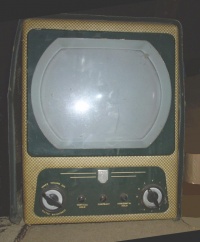Difference between revisions of "Appliance energy saving"
Jump to navigation
Jump to search
(can tidy it up later) |
(pic) |
||
| Line 1: | Line 1: | ||
| + | [[image:220-8_1954_TV.jpg|right|200px]] | ||
| + | |||
The reduced energy use never pays back the added purchase price on a new LCD TV. | The reduced energy use never pays back the added purchase price on a new LCD TV. | ||
Revision as of 15:20, 5 September 2010
The reduced energy use never pays back the added purchase price on a new LCD TV.
How would you go about calculating that ?
First you'd need to know the power consumption of the 2 sets you want to compare. The label on the set indicates the max consumption, and figures can be calculated from those. If you want more precision, you'd hook the 2 upto an energy consumption meter (killawatt etc) and measure their consumption exactly.
Example:
Say a TV eats 100w and you watch it for 2 hr per day. (I'm picking easy figures)
- Consumption = 0.1kW x 2hrs = 0.2kWh per day = 73kWh / yr
- Price of electricity = 12p/kWh
- So annual energy cost = 73 x 12p = £8.76 / yr
- If typical life expectancy of appliance = 8 yrs, thats £70 per life of the product.
Now compare an LCD with 70w consumption
- cost/yr = £6.13/yr = £49/ 8yrs
- Difference = 70-49 = £21
Difference in purchase price is greater, so the LCD never pays its savings back.
